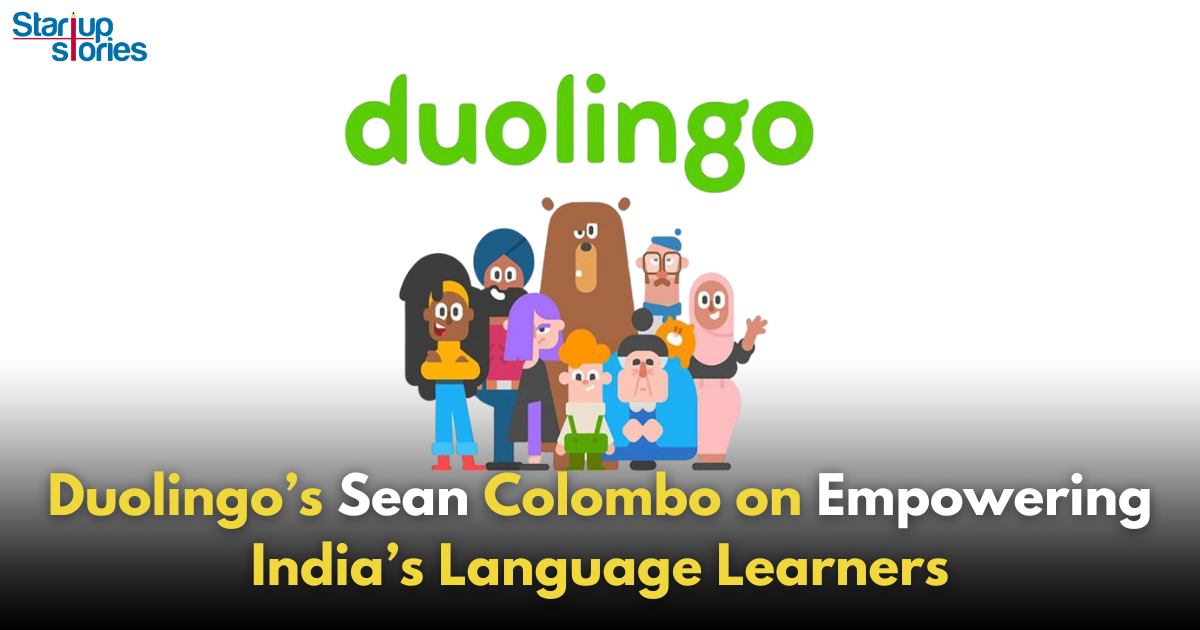Latest News
“Fun, Free, and Effective”: How Duolingo’s Sean Colombo Describes the App’s Popularity in India!

Duolingo’s mission to make high-quality education accessible to all has driven the app’s growth worldwide, including its significant rise in India. According to Sean Colombo, Duolingo’s global VP of engineering, the app’s appeal lies in its simple approach: being “fun, free, and effective.” Launched in 2013, Duolingo experienced a surge in popularity during the COVID-19 pandemic as people sought ways to learn new languages from home.
Duolingo’s Journey and User Growth
In an in-depth conversation with indianexpress.com, Colombo reflected on Duolingo’s journey, user growth, and success in both global and Indian markets. Originally launched in 2012 by Luis von Ahn, known for creating CAPTCHA, and Swiss computer scientist Severin Hacker, Duolingo quickly grew into one of the world’s leading language-learning platforms. The app’s unique focus on languages stems from its real-world impact on individuals’ career prospects. Unlike traditional education paths that require credentials, language skills can enhance job opportunities across multiple industries, offering an immediate advantage.
Impact of the COVID-19 Pandemic
The pandemic accelerated Duolingo’s growth as more users turned to digital learning. The app gained mainstream visibility, solidifying its presence in pop culture and significantly expanding its user base. Today, Duolingo boasts over 100 million monthly active users worldwide, including over a million daily users in India, which has become the app’s fifth-largest market.
India’s Growing Market for Language Learning
India represents a key growth market for Duolingo. Colombo emphasized that the app’s popularity has been organic, with strong user growth across the country. To cater to India’s linguistic diversity, Duolingo has introduced courses in Hindi, Bengali, and Telugu, with Tamil and Punjabi expected soon.
Accessibility Initiatives
Colombo noted that to improve accessibility, Duolingo has prioritized Android compatibility and kept the app size small, making it more accessible in rural areas. The company has ramped up its hiring in Bengaluru to strengthen its local engineering and product teams.
Duolingo first entered the Indian market in 2016, initially offering English courses for Hindi speakers. Since then, it has expanded to offer additional languages such as Bengali in 2022 and Telugu in 2023. Today, the most popular languages for Indian users include English, Hindi, Japanese, French, German/Spanish, and Korean. Notably, 78% of Indian learners are under 30 years old, with motivations ranging from academic and professional development to brain training and reconnecting with family members abroad.
User-Centric Design and Data-Driven Improvement
Colombo attributes Duolingo’s success to its simple, user-friendly design and extensive data-driven improvements. By leveraging data from millions of users, the app is constantly fine-tuned to enhance engagement and reduce complexity. “We make learning engaging yet accessible, which is essential to keep users motivated,” Colombo stated.
Expanding Beyond Languages
Beyond language learning, Duolingo has expanded into math and music education following its public listing. For instance, Duolingo’s music course uses cutting-edge features such as pitch detection, allowing users to practice real instruments while the app tracks their progress.
AI: The Future of Language Learning
Artificial intelligence plays a significant role in Duolingo’s platform, transforming how language skills are taught. Colombo explained that AI-powered models can predict a user’s likelihood of success on exercises, making lessons challenging yet approachable. He believes that the future of language learning will increasingly rely on AI-driven tools, including generative AI and live conversation-based exercises.
Enhancing User Experience with AI
AI integration allows for personalized learning experiences tailored to individual users’ needs. This adaptability enhances engagement by providing targeted practice based on user performance.
Conclusion
According to Colombo, Duolingo’s unique appeal comes down to its core values—being “fun, free, and effective.” These elements are supported by expert linguists and a gamified experience that has created a platform balancing educational rigor with user engagement.
As Duolingo continues to expand its offerings and adapt to user needs in diverse markets like India, it remains committed to fulfilling its mission of making quality education universally accessible. The integration of AI tools further positions Duolingo as a leader in language learning innovation while empowering users to achieve their educational goals effectively.
Latest News
Zerodha Reports 23% Profit Decline in FY25 as Revenues Miss Target

Zerodha experienced a challenging FY25, as its revenue fell 11.5% to ₹8,847 crore and net profit dropped 22.9% to ₹4,237 crore. This decline reflects tougher regulatory conditions, lower trading volumes, and increased operational costs in the brokerage market, all of which impacted core earning segments for the company.
Despite these headwinds, Zerodha improved its operating margin to 63.78% and built up significant cash reserves, reporting ₹22,679 crore in bank balances. Salary expenses and director remuneration increased, but disciplined cost controls helped the company maintain profitability and a debt-free balance sheet. The drop in active clients and increased compliance costs further contributed to the profit contraction.
Looking ahead, Zerodha’s resilience is supported by its robust cash position and operational efficiency. Maintaining steady margins, diversifying product offerings, and investing in technology positions the company to withstand future regulatory fluctuations and changing market sentiment reinforcing its status as one of India’s leading brokerage firms.
Latest News
Zoho Pay Debuts as India’s New UPI Challenger, Taking on PhonePe, Paytm, and Google Pay

Zoho Corporation has expanded its fintech portfolio with the launch of Zoho Pay, a UPI-based payments app built to challenge India’s top digital payment giants such as PhonePe, Paytm, and Google Pay. The new app supports peer-to-peer transfers, bill payments, QR-based transactions, and merchant settlements in a streamlined interface. Available as both a standalone app and an integrated feature inside Zoho’s privacy-driven messenger Arattai, Zoho Pay enables users to handle chats and payments in one platform, emphasizing data privacy and Made-in-India innovation.
Through seamless integration with Arattai, Zoho Pay allows users to send or request payments, split expenses, and conduct UPI-based transactions directly in their chat windows. Users can link bank accounts, scan dynamic QR codes, and receive audio confirmations of payments, ensuring speed and security. This design mirrors the simplicity of India’s leading UPI apps but is powered by Zoho’s non-advertising, privacy-first model. The integration aligns with Zoho’s mission to build a self-reliant digital ecosystem, where messaging and money management coexist securely.
In the competitive digital payments market, Zoho Pay differentiates itself through its tight business software integration with apps like Zoho Books, Zoho Payroll, and Zoho Commerce, offering small businesses unified access to payments, billing, and accounting. The company is also expanding its reach with POS devices for merchants featuring UPI QR, card payments, and instant reconciliation tools. With founder Sridhar Vembu’s vision of a ‘Chat + Pay’ ecosystem, Zoho Pay reflects a bold step toward redefining India’s fintech scene with a secure, ad-free, and locally developed alternative to global payment platforms.
Latest News
Meta Expands AI-Powered Reels Translation to Hindi and Portuguese, Enhancing Global Creator Reach

Meta has expanded its AI-powered translation feature for Reels to include Hindi and Portuguese, joining English and Spanish in empowering creators to reach a broader global audience on Instagram and Facebook. Originally launched in August 2025 with support for English and Spanish, this update now allows creators to seamlessly translate and dub their short videos, breaking language barriers across some of the largest Reels markets worldwide. The AI technology mimics the creator’s voice tone and even offers lip-syncing to ensure the translated videos feel natural and engaging for viewers.
This enhancement is especially significant for India, the largest market for Facebook and Instagram, where over 600 million people speak Hindi. Content creators who are not fluent in Hindi can now easily access this vast audience, increasing their reach and engagement across diverse linguistic groups. To maintain transparency, all translated Reels are clearly labeled with “Translated with Meta AI,” and viewers can choose to switch translations on or off based on their preference.
In addition to voice dubbing, Meta is developing features to translate captions and text stickers on Reels, making content more accessible even without sound. These AI translation tools are available free for eligible public Instagram accounts and Facebook creator profiles with over 1,000 followers. This innovation reinforces Meta’s commitment to fostering cross-cultural content sharing and enhancing creators’ ability to connect with audiences around the world through short-form videos.














"oppna ett binance-konto
March 1, 2025 at 7:27 am
I don’t think the title of your article matches the content lol. Just kidding, mainly because I had some doubts after reading the article.
J88
November 5, 2025 at 2:42 pm
Đến với J88, bạn sẽ được trải nghiệm dịch vụ cá cược chuyên nghiệp cùng hàng ngàn sự kiện khuyến mãi độc quyền.
Kuwin
November 6, 2025 at 7:13 pm
kuwin sở hữu kho game đa dạng từ slot đến trò chơi bài đổi thưởng, mang đến cho bạn những giây phút giải trí tuyệt vời.
站群程序
November 11, 2025 at 5:01 am
采用高效谷歌站群策略,快速提升网站在搜索引擎中的可见性与权重。谷歌站群
站群程序
November 12, 2025 at 8:36 pm
搭载智能站群程序,自动化搭建与管理,为SEO项目提供核心驱动力。站群程序
GO88
November 20, 2025 at 4:58 pm
Tham gia cộng đồng game thủ tại Go88 để trải nghiệm các trò chơi bài, poker phổ biến nhất hiện nay.